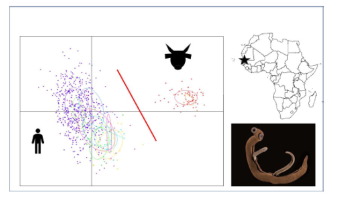当前位置:
X-MOL 学术
›
Int. J. Parasitol.
›
论文详情
Our official English website, www.x-mol.net, welcomes your feedback! (Note: you will need to create a separate account there.)
No barrier breakdown between human and cattle schistosome species in the Senegal River Basin in the face of hybridisation.
International Journal for Parasitology ( IF 4 ) Pub Date : 2019-11-14 , DOI: 10.1016/j.ijpara.2019.08.004 Nele A M Boon 1 , Moustapha Mbow 2 , Linda Paredis 3 , Pieter Moris 4 , Ibrahima Sy 5 , Tim Maes 6 , Bonnie L Webster 7 , Moussa Sacko 8 , Filip A M Volckaert 3 , Katja Polman 9 , Tine Huyse 6
International Journal for Parasitology ( IF 4 ) Pub Date : 2019-11-14 , DOI: 10.1016/j.ijpara.2019.08.004 Nele A M Boon 1 , Moustapha Mbow 2 , Linda Paredis 3 , Pieter Moris 4 , Ibrahima Sy 5 , Tim Maes 6 , Bonnie L Webster 7 , Moussa Sacko 8 , Filip A M Volckaert 3 , Katja Polman 9 , Tine Huyse 6
Affiliation

|
Schistosomiasis is widely distributed along the Senegal River Basin (SRB), affecting both the human population and their livestock. Damming of the Senegal River for irrigation purposes in the 1980s induced ecological changes that resulted in a large outbreak of Schistosoma mansoni, followed a few years later by an increase and spread of Schistosoma haematobium infections. The presence of hybrid crosses between the human and cattle schistosomes, S. haematobium and Schistosoma bovis, respectively, is adding complexity to the disease epidemiology in this area, and questions the strength of the species boundary between these two species. This study aimed to investigate the epidemiology of S. haematobium, S. bovis and their hybrids along the Senegal River basin using both microsatellite genetic markers and analysis of mitochondrial and nuclear DNA markers. Human schistosome populations with a S. haematobium cox1 mtDNA profile and those with a S. bovis cox1 mtDNA profile (the so-called hybrids) appear to belong to a single randomly mating population, strongly differentiated from the pure S. bovis found in cattle. These results suggest that, in northern Senegal, a strong species boundary persists between human and cattle schistosome species and there is no prolific admixing of the populations. In addition, we found that in the SRB S. haematobium was spatially more differentiated in comparison to S. mansoni. This may be related either to the presence and susceptibility of the intermediate snail hosts, or to the colonisation history of the parasite.
中文翻译:

面对杂交,塞内加尔河流域的人类和牛血吸虫物种之间没有屏障破坏。
血吸虫病广泛分布在塞内加尔河流域(SRB)上,既影响人口,也影响牲畜。塞内加尔河在1980年代的灌溉目的筑坝引起了生态变化,导致曼氏血吸虫大面积爆发,随后几年血吸虫血吸虫感染增加并扩散。人类和牛血吸虫,血吸虫和牛血吸虫之间存在杂交杂交,这增加了该地区疾病流行病学的复杂性,并质疑这两个物种之间物种边界的强度。这项研究旨在调查血球链球菌S.haematobium的流行病学。使用微卫星遗传标记以及线粒体和核DNA标记的分析,在塞内加尔河沿岸的牛和牛及其杂种。具有血球链球菌cox1 mtDNA谱的人类血吸虫种群和具有牛链球菌cox1 mtDNA谱的人类血吸虫种群(所谓的杂种)似乎属于单个随机交配种群,与牛中的纯牛链球菌有很大区别。这些结果表明,在塞内加尔北部,人类和牛的血吸虫物种之间仍然存在牢固的物种边界,并且种群之间没有多产的混合。此外,我们发现,在SRB中,与曼氏沙门氏菌相比,血球链球菌在空间上具有更大的分化能力。这可能与中间蜗牛宿主的存在和易感性有关,也可能与寄生虫的定殖历史有关。具有血球链球菌cox1 mtDNA谱的人类血吸虫种群和具有牛链球菌cox1 mtDNA谱的人类血吸虫种群(所谓的杂种)似乎属于单个随机交配种群,与牛中的纯牛链球菌有很大区别。这些结果表明,在塞内加尔北部,人类和牛的血吸虫物种之间仍然存在牢固的物种边界,并且种群之间没有多产的混合。此外,我们发现,在SRB中,与曼氏沙门氏菌相比,血球链球菌在空间上具有更大的分化能力。这可能与中间蜗牛宿主的存在和易感性有关,也可能与寄生虫的定殖历史有关。具有血球链球菌cox1 mtDNA图谱的人类血吸虫种群和具有牛链球菌cox1 mtDNA谱图的人类血吸虫种群(所谓的杂种)似乎属于单个随机交配种群,与在牛中发现的纯牛链球菌有很大区别。这些结果表明,在塞内加尔北部,人类和牛的血吸虫物种之间仍然存在牢固的物种边界,并且种群之间没有多产的混合。此外,我们发现,在SRB中,与曼氏沙门氏菌相比,血球链球菌在空间上具有更大的分化能力。这可能与中间蜗牛宿主的存在和易感性有关,也可能与寄生虫的定殖历史有关。牛牛cox1 mtDNA谱(所谓的杂种)似乎属于一个随机交配的种群,与牛中的纯牛链球菌有很大的区别。这些结果表明,在塞内加尔北部,人类和牛的血吸虫物种之间仍然存在牢固的物种边界,并且种群之间没有多产的混合。此外,我们发现,在SRB中,与曼氏沙门氏菌相比,血球链球菌在空间上具有更大的分化能力。这可能与中间蜗牛宿主的存在和易感性有关,也可能与寄生虫的定殖历史有关。牛牛cox1 mtDNA谱(所谓的杂种)似乎属于一个随机交配的种群,与牛中的纯牛链球菌有很大的区别。这些结果表明,在塞内加尔北部,人类和牛的血吸虫物种之间仍然存在牢固的物种边界,并且种群之间没有多产的混合。此外,我们发现,在SRB中,与曼氏沙门氏菌相比,血球链球菌在空间上具有更大的分化能力。这可能与中间蜗牛宿主的存在和易感性有关,也可能与寄生虫的定殖历史有关。人类和牛的血吸虫物种之间仍然存在着牢固的物种边界,并且种群之间没有多产的混合。此外,我们发现,在SRB中,与曼氏链球菌相比,嗜血链球菌在空间上具有更大的分化能力。这可能与中间蜗牛宿主的存在和易感性有关,也可能与寄生虫的定殖历史有关。人类和牛的血吸虫物种之间仍然存在着牢固的物种边界,并且种群之间没有多产的混合。此外,我们发现,在SRB中,与曼氏沙门氏菌相比,血球链球菌在空间上具有更大的分化能力。这可能与中间蜗牛宿主的存在和易感性有关,也可能与寄生虫的定殖历史有关。
更新日期:2019-11-14
中文翻译:

面对杂交,塞内加尔河流域的人类和牛血吸虫物种之间没有屏障破坏。
血吸虫病广泛分布在塞内加尔河流域(SRB)上,既影响人口,也影响牲畜。塞内加尔河在1980年代的灌溉目的筑坝引起了生态变化,导致曼氏血吸虫大面积爆发,随后几年血吸虫血吸虫感染增加并扩散。人类和牛血吸虫,血吸虫和牛血吸虫之间存在杂交杂交,这增加了该地区疾病流行病学的复杂性,并质疑这两个物种之间物种边界的强度。这项研究旨在调查血球链球菌S.haematobium的流行病学。使用微卫星遗传标记以及线粒体和核DNA标记的分析,在塞内加尔河沿岸的牛和牛及其杂种。具有血球链球菌cox1 mtDNA谱的人类血吸虫种群和具有牛链球菌cox1 mtDNA谱的人类血吸虫种群(所谓的杂种)似乎属于单个随机交配种群,与牛中的纯牛链球菌有很大区别。这些结果表明,在塞内加尔北部,人类和牛的血吸虫物种之间仍然存在牢固的物种边界,并且种群之间没有多产的混合。此外,我们发现,在SRB中,与曼氏沙门氏菌相比,血球链球菌在空间上具有更大的分化能力。这可能与中间蜗牛宿主的存在和易感性有关,也可能与寄生虫的定殖历史有关。具有血球链球菌cox1 mtDNA谱的人类血吸虫种群和具有牛链球菌cox1 mtDNA谱的人类血吸虫种群(所谓的杂种)似乎属于单个随机交配种群,与牛中的纯牛链球菌有很大区别。这些结果表明,在塞内加尔北部,人类和牛的血吸虫物种之间仍然存在牢固的物种边界,并且种群之间没有多产的混合。此外,我们发现,在SRB中,与曼氏沙门氏菌相比,血球链球菌在空间上具有更大的分化能力。这可能与中间蜗牛宿主的存在和易感性有关,也可能与寄生虫的定殖历史有关。具有血球链球菌cox1 mtDNA图谱的人类血吸虫种群和具有牛链球菌cox1 mtDNA谱图的人类血吸虫种群(所谓的杂种)似乎属于单个随机交配种群,与在牛中发现的纯牛链球菌有很大区别。这些结果表明,在塞内加尔北部,人类和牛的血吸虫物种之间仍然存在牢固的物种边界,并且种群之间没有多产的混合。此外,我们发现,在SRB中,与曼氏沙门氏菌相比,血球链球菌在空间上具有更大的分化能力。这可能与中间蜗牛宿主的存在和易感性有关,也可能与寄生虫的定殖历史有关。牛牛cox1 mtDNA谱(所谓的杂种)似乎属于一个随机交配的种群,与牛中的纯牛链球菌有很大的区别。这些结果表明,在塞内加尔北部,人类和牛的血吸虫物种之间仍然存在牢固的物种边界,并且种群之间没有多产的混合。此外,我们发现,在SRB中,与曼氏沙门氏菌相比,血球链球菌在空间上具有更大的分化能力。这可能与中间蜗牛宿主的存在和易感性有关,也可能与寄生虫的定殖历史有关。牛牛cox1 mtDNA谱(所谓的杂种)似乎属于一个随机交配的种群,与牛中的纯牛链球菌有很大的区别。这些结果表明,在塞内加尔北部,人类和牛的血吸虫物种之间仍然存在牢固的物种边界,并且种群之间没有多产的混合。此外,我们发现,在SRB中,与曼氏沙门氏菌相比,血球链球菌在空间上具有更大的分化能力。这可能与中间蜗牛宿主的存在和易感性有关,也可能与寄生虫的定殖历史有关。人类和牛的血吸虫物种之间仍然存在着牢固的物种边界,并且种群之间没有多产的混合。此外,我们发现,在SRB中,与曼氏链球菌相比,嗜血链球菌在空间上具有更大的分化能力。这可能与中间蜗牛宿主的存在和易感性有关,也可能与寄生虫的定殖历史有关。人类和牛的血吸虫物种之间仍然存在着牢固的物种边界,并且种群之间没有多产的混合。此外,我们发现,在SRB中,与曼氏沙门氏菌相比,血球链球菌在空间上具有更大的分化能力。这可能与中间蜗牛宿主的存在和易感性有关,也可能与寄生虫的定殖历史有关。


























 京公网安备 11010802027423号
京公网安备 11010802027423号